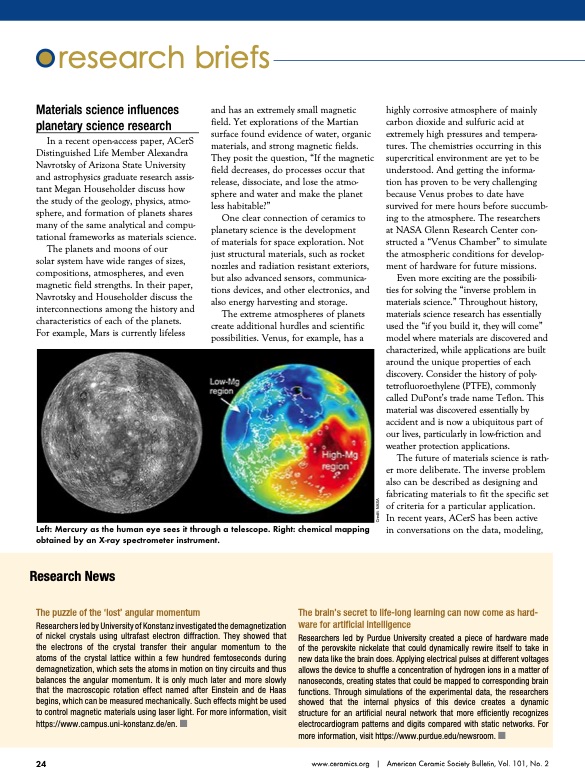
PDF Publication Title:
Text from PDF Page: 026
Research News The puzzle of the ‘lost’ angular momentum Researchers led by University of Konstanz investigated the demagnetization of nickel crystals using ultrafast electron diffraction. They showed that the electrons of the crystal transfer their angular momentum to the atoms of the crystal lattice within a few hundred femtoseconds during demagnetization, which sets the atoms in motion on tiny circuits and thus balances the angular momentum. It is only much later and more slowly that the macroscopic rotation effect named after Einstein and de Haas begins,whichcanbemeasuredmechanically.Sucheffectsmightbeused to control magnetic materials using laser light. For more information, visit https://www.campus.uni-konstanz.de/en. n The brain’s secret to life-long learning can now come as hard- ware for artificial intelligence Researchers led by Purdue University created a piece of hardware made of the perovskite nickelate that could dynamically rewire itself to take in new data like the brain does. Applying electrical pulses at different voltages allows the device to shuffle a concentration of hydrogen ions in a matter of nanoseconds, creating states that could be mapped to corresponding brain functions. Through simulations of the experimental data, the researchers showed that the internal physics of this device creates a dynamic structure for an artificial neural network that more efficiently recognizes electrocardiogram patterns and digits compared with static networks. For more information, visit https://www.purdue.edu/newsroom. n research briefs Materials science influences planetary science research In a recent open-access paper, ACerS Distinguished Life Member Alexandra Navrotsky of Arizona State University and astrophysics graduate research assis- tant Megan Householder discuss how the study of the geology, physics, atmo- sphere, and formation of planets shares many of the same analytical and compu- tational frameworks as materials science. The planets and moons of our solar system have wide ranges of sizes, compositions, atmospheres, and even magnetic field strengths. In their paper, Navrotsky and Householder discuss the interconnections among the history and characteristics of each of the planets. For example, Mars is currently lifeless and has an extremely small magnetic field. Yet explorations of the Martian surface found evidence of water, organic materials, and strong magnetic fields. They posit the question, “If the magnetic field decreases, do processes occur that release, dissociate, and lose the atmo- sphere and water and make the planet less habitable?” One clear connection of ceramics to planetary science is the development of materials for space exploration. Not just structural materials, such as rocket nozzles and radiation resistant exteriors, but also advanced sensors, communica- tions devices, and other electronics, and also energy harvesting and storage. The extreme atmospheres of planets create additional hurdles and scientific possibilities. Venus, for example, has a highly corrosive atmosphere of mainly carbon dioxide and sulfuric acid at extremely high pressures and tempera- tures. The chemistries occurring in this supercritical environment are yet to be understood. And getting the informa- tion has proven to be very challenging because Venus probes to date have survived for mere hours before succumb- ing to the atmosphere. The researchers at NASA Glenn Research Center con- structed a “Venus Chamber” to simulate the atmospheric conditions for develop- ment of hardware for future missions. Even more exciting are the possibili- ties for solving the “inverse problem in materials science.” Throughout history, materials science research has essentially used the “if you build it, they will come” model where materials are discovered and characterized, while applications are built around the unique properties of each discovery. Consider the history of poly- tetrofluoroethylene (PTFE), commonly called DuPont’s trade name Teflon. This material was discovered essentially by accident and is now a ubiquitous part of our lives, particularly in low-friction and weather protection applications. The future of materials science is rath- er more deliberate. The inverse problem also can be described as designing and fabricating materials to fit the specific set of criteria for a particular application. In recent years, ACerS has been active in conversations on the data, modeling, Left: Mercury as the human eye sees it through a telescope. Right: chemical mapping obtained by an X-ray spectrometer instrument. 24 www.ceramics.org | American Ceramic Society Bulletin, Vol. 101, No. 2 Credit: NASAPDF Image | hydrogen as an alternative fuel

PDF Search Title:
hydrogen as an alternative fuelOriginal File Name Searched:
March2022.pdfDIY PDF Search: Google It | Yahoo | Bing
CO2 Organic Rankine Cycle Experimenter Platform The supercritical CO2 phase change system is both a heat pump and organic rankine cycle which can be used for those purposes and as a supercritical extractor for advanced subcritical and supercritical extraction technology. Uses include producing nanoparticles, precious metal CO2 extraction, lithium battery recycling, and other applications... More Info
Heat Pumps CO2 ORC Heat Pump System Platform More Info
| CONTACT TEL: 608-238-6001 Email: greg@infinityturbine.com | RSS | AMP |